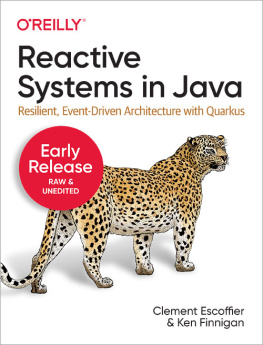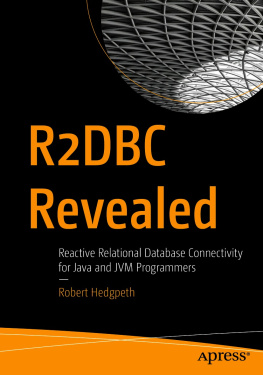Clement Escoffier - Reactive Systems in Java
Here you can read online Clement Escoffier - Reactive Systems in Java full text of the book (entire story) in english for free. Download pdf and epub, get meaning, cover and reviews about this ebook. year: 2021, publisher: OReilly Media, Inc., genre: Computer. Description of the work, (preface) as well as reviews are available. Best literature library LitArk.com created for fans of good reading and offers a wide selection of genres:
Romance novel
Science fiction
Adventure
Detective
Science
History
Home and family
Prose
Art
Politics
Computer
Non-fiction
Religion
Business
Children
Humor
Choose a favorite category and find really read worthwhile books. Enjoy immersion in the world of imagination, feel the emotions of the characters or learn something new for yourself, make an fascinating discovery.
- Book:Reactive Systems in Java
- Author:
- Publisher:OReilly Media, Inc.
- Genre:
- Year:2021
- Rating:3 / 5
- Favourites:Add to favourites
- Your mark:
- 60
- 1
- 2
- 3
- 4
- 5
Reactive Systems in Java: summary, description and annotation
We offer to read an annotation, description, summary or preface (depends on what the author of the book "Reactive Systems in Java" wrote himself). If you haven't found the necessary information about the book — write in the comments, we will try to find it.
Reactive Systems in Java — read online for free the complete book (whole text) full work
Below is the text of the book, divided by pages. System saving the place of the last page read, allows you to conveniently read the book "Reactive Systems in Java" online for free, without having to search again every time where you left off. Put a bookmark, and you can go to the page where you finished reading at any time.
Font size:
Interval:
Bookmark:

by Clement Escoffier and Ken Finnigan
Copyright 2021 Clement Escoffier and Ken Finnigan. All rights reserved.
Printed in the United States of America.
Published by OReilly Media, Inc. , 1005 Gravenstein Highway North, Sebastopol, CA 95472.
OReilly books may be purchased for educational, business, or sales promotional use. Online editions are also available for most titles (http://oreilly.com). For more information, contact our corporate/institutional sales department: 800-998-9938 or corporate@oreilly.com .
- Acquisitions Editor: Suzanne McQuade
- Development Editor: Jill Leonard
- Production Editor: Caitlin Ghegan
- Copyeditor: TK
- Proofreader: TK
- Indexer: TK
- Interior Designer: David Futato
- Cover Designer: Karen Montgomery
- Illustrator: Kate Dullea
- January 2022: First Edition
- 2021-04-20: First Release
- 2021-08-02: Second Release
See http://oreilly.com/catalog/errata.csp?isbn=9781492091653 for release details.
The OReilly logo is a registered trademark of OReilly Media, Inc. Reactive Systems in Java, the cover image, and related trade dress are trademarks of OReilly Media, Inc.
The views expressed in this work are those of the author(s), and do not represent the publishers views. While the publisher and the author(s) have used good faith efforts to ensure that the information and instructions contained in this work are accurate, the publisher and the author(s) disclaim all responsibility for errors or omissions, including without limitation responsibility for damages resulting from the use of or reliance on this work. Use of the information and instructions contained in this work is at your own risk. If any code samples or other technology this work contains or describes is subject to open source licenses or the intellectual property rights of others, it is your responsibility to ensure that your use thereof complies with such licenses and/or rights.
978-1-492-09165-3
[FILL IN]
With Early Release ebooks, you get books in their earliest formthe authors raw and unedited content as they writeso you can take advantage of these technologies long before the official release of these titles.
This will be the 1st chapter of the final book. Please note that the GitHub repo will be made active later on.
If you have comments about how we might improve the content and/or examples in this book, or if you notice missing material within this chapter, please reach out to the authors at (Ken Finnigan).
Reactive is an overloaded word.If you are reading this book, you probably searched for reactive with a search engine to understand what its all about.If you didnt, no worries, you save yourself from a lot of confusion.There are many reactive things: reactive systems, reactive programming, reactive extensions, reactive messaging.Every day new ones pop up.Are all these reactives the same reactive?Are they different?
These are the questions we are going to answer in this chapter.We are going to sneak a peek at the reactive landscape to identify and understand these different nuances of reactive, what they mean, the concepts associated with them, and how do they relate to each other.Because yes, without spoiling too much, all these reactives are related.
As said in the preface, in this book, we use the noun Reactive, with an uppercase R, to aggregate all the various facets of the reactive landscape, such as reactive programming, reactive systems, reactive streams, and so on.
Lets start at the beginning.Forget about software and IT for a few minutes, and use an out-of-fashion approach.If we look for reactive in the Oxford dictionary, we find the following definition:
*reactive*ADJECTIVE1. Showing a response to a stimulus.1.1 Acting in response to a situation rather than creating or controlling it.1.2 Having a tendency to react chemically.1.3 (Physiology) Showing an immune response to a specific antigen.1.4 (of a disease or illness) caused by a reaction to something.1.5 (Physics) Relating to reactance.Among these definitions, two are relevant in our context.The first definition, showing a response to a stimulus, refers to some kind of reaction.Being reactive means reacting to stimuli, whatever they are.Sub-definition 1.1 says that being reactive is also about facing unexpected and uncontrolled situations.We will see along with this book, that Cloud-Native applications, and distributed systems in general, face plenty of such kind of situation.
But, while these definitions are interesting, they dont apply to software.So, lets make one.Taking these definitions into account, we can add a new one specific to software:
1.6 (Software) Application reacting to stimuli, such as user events, requests,and failures.But, we will see in this book that todays reactive goes beyond this.Reactive is an approach to design, implement, and reason about your system in term of events and flows.Reactive is about building responsive, resilient, and elastic applications.Reactive is also about resource utilization through efficient management of resources and communication.
To put another way: Reactive is about designing and building better distributed systems.More robust, more efficient.We call them: reactive systems.
But wait, the definition (1.6) we just gave; its not groundbreaking.On the contrary, it looks dj-vu, no?
Isnt the nature of software to react to user inputs, and operating systems signals?How does a software behave when you hit a keystroke, it reacts.So, why so many books, talks and debate about it if its just regular software?Please be patient; there is a bit more about it.
But you are right; Reactive is not new.Its actually pretty old.We can track the foundation of the ideas behind reactive software just after the apparition of computers in the 50s.The DYSEAC, a first-generation computer (in operation in 1954), was already using hardware interrupts as an optimization, eliminating waiting time in polling loops, waiting for external events.This computer was one of the first systems to use reactive and event-driven architecture!
Reacting to events implies being event-driven.Event-driven software receives and produces events.The received events determine the flow of the program.A fundamental aspect of this event-driven aspect is the asynchronous nature of event-driven architecture.You dont know when you are going to receive events.It is precisely the (1.1) definition from the previous section.You cannot plan when you will receive events; you are not in control of which events you will get; you need to be prepared to handle them.
Thats the essence of being reactive: being asynchronous.
From this idea of being asynchronous and event-driven, many forms of Reactive have emerged.The reactive landscape is broad and crowded.
But dont forget our objective: building better distributed systems - reactive systems.The other reactives are here to help us implement these systems.
The reasons for Reactive, and reactive systems in particular, come from distributed systems.As we will see in introducing the concept of reactive systems.
Font size:
Interval:
Bookmark:
Similar books «Reactive Systems in Java»
Look at similar books to Reactive Systems in Java. We have selected literature similar in name and meaning in the hope of providing readers with more options to find new, interesting, not yet read works.
Discussion, reviews of the book Reactive Systems in Java and just readers' own opinions. Leave your comments, write what you think about the work, its meaning or the main characters. Specify what exactly you liked and what you didn't like, and why you think so.













